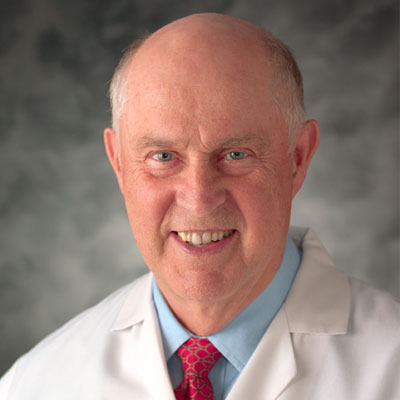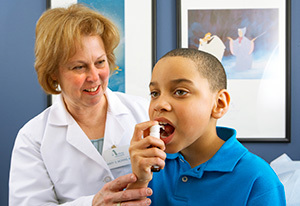Allergy desensitization done by the mouth dates back as early as 1900 when New York physician H.H. Curtis relieved his patients’ hay fever by placing pollen antigen drops in their mouths. But it wasn’t until the 1920s that placing allergy drops under the tongue truly became part of allergy history.
St. Louis ENT doctor French Hansel experimented with sublingual drops for dust mites while he was a Mayo Clinic fellow in the 1920s and published his results in 1936. He was the first to observe that placing antigen drops under the tongue prompted faster, more effective desensitization than in any other part of the mouth.
A new generation of physicians resurrected interest in sublingual immunotherapy in the 1960s. It was in 1966 that our clinic founder, David L. Morris, MD, attended his first sublingual immunotherapy conference. He’d been searching for an effective way to treat his mold allergic patients; mold exposure was an occupational hazard to dairy farmers. Many were non-smokers, yet they often suffered from chronic obstructive pulmonary disease (COPD). Also called hypersensitivity pneumonititis, Farmer’s Lung usually includes asthma caused by allergies to mold that grows in hay that is baled wet.

In Wisconsin’s humid summers, hay was nearly impossible to dry completely before baling. Damp hay stacked in small bales warmed as if composted, creating ideal conditions for mold growth that released billions of mold spores when the bales were opened and used for animal feed. Often these patients would feel so sick after receiving allergy shots that it was hard for them to work. In addition, busy farming schedules made it difficult for farmers to come to Dr. Morris’ office frequently for injections.
When Dr. Morris first started his Wednesday night allergy clinic, he began offering patients a choice: shots or drops. “After three years,” said Morris, “no one was lining up for shots anymore since they were more interested in allergy drops.”
In 1970, Dr. Morris opened Allergy Associates of La Crosse, a sole sublingual immunotherapy clinic
Since that time, he and his physician partners have treated more than 275,000 patients with a wide variety of allergic conditions using allergy drops.
In addition to treating complex allergic patients from around the country, the physician partners from Allergy Associates of La Crosse have remained dedicated to sharing their knowledge of sublingual immunotherapy with other physicians. This dedication led to the development of Allergychoices, Inc., a healthcare company that provides tools and services to enable physicians to provide sublingual immunotherapy to their patients, and gives allergy sufferers information and access to practices offering sublingual immunotherapy. Allergy Associates’ physicians have provided training and education to leading medical university hospitals, branches of the U.S. military healthcare, and a number of private practices, with many of those now treating patients with the La Crosse Method™ Practice Protocol.
Dr. Morris first began publishing research papers in medical literature examining the sublingual treatment of allergies to foods and inhalants in 1969. Today, we continue to work toward better understanding of sublingual immunotherapy’s effectiveness through research at our clinic and by developing research partnerships around the world.
Sublingual Immunotherapy Milestones
1900 – First allergy desensitization done by mouth by H.H. Curtis
1936 – Dr. French Hansel publishes results of sublingual study on dust mites
1966 – Dr. David Morris attends first sublingual immunotherapy workshop
1969 – Dr. Morris publishes a paper about sublingual immunotherapy for food allergies
1970 – Dr. Morris publishes a paper, “SLIT for respiratory diseases caused by mold allergy”
1970 – Allergy Associates of La Crosse opens in the Franciscan Skemp Professional Arts Building
1972 – Allergy Associates discontinues allergy shot therapy and offers only sublingual immunotherapy
1998 – The World Health Organization endorses sublingual immunotherapy as a viable alternative to injection immunotherapy
2001 – Allergic Rhinitis and its Impact on Asthma (ARIA) endorses sublingual immunotherapy
2001-02 – Allergy Associates physicians begin sharing the “La Crosse Method Practice Protocol” at their annual education program and develop Allergychoices, Inc.
2003 – Allergy Associates of La Crosse physicians write lead chapter in Karger’s Local Immunotherapy in Allergy publication.
2005 – Dr. Mary Morris teams with Duke University to study sublingual immunotherapy for peanut allergy
2007 – ARIA notes more sublingual immunotherapy research is being conducted than allergy shots or subcutaneous immunotherapy, and the research is higher quality
2009 – Dr. Demetrios Theodoropoulos, Dr. Mary and Dr. David Morris publish a paper on the mechanisms of sublingual immunotherapy in Drugs of Today
2010 – Cochrane Review provides update to sublingual immunotherapy for allergic rhinitis concluding safety and symptom and medication reduction compared to placebo
2013 – Agency for Healthcare Research Quality (AHRQ) publishes comparative effectiveness review finding allergy drops and shots are safe and effective for allergic rhinitis and asthma
